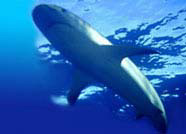


Social Behavior

 |
 |
 |
|||
| Home | Evolution
| Classification
| Glossary | Biology
| Behavior | Shark
Repellent | Shark
Conservation | Do's &
Don'ts | Did You Know?
Social Behavior |
 |
||||
|
When food is concentrated, such as a whale carcass
or a tightly packed shoal of fish or squid, many sharks must feed together
and, while feeding frenzies (when sharks bite at anything and everything
including others of their own kind) have been initiated by artificial
feeding, in the wild there is some degree of order amongst diners. There
are rules in shark society. Generally, small sharks defer to large sharks,
but there is more to it than that.
The great whites were once thought to be solitary nomads, but it is now thought that they are probably more social individuals showing complex relationships with other animals. Pairs or small groups of sharks of roughly the same sex and age return to the same area each year. Off the Farallon Island, to the west of San Francisco, two recognisable females, known to local shark researchers as 'The Sisterhood', always turn up in the same patch of sea each winter to stake out the breeding rookeries of northern elephant seals and California sea lions. They arrive at the same time, patrol the same bays and are present at each other's kills. They appear to communicate not with sounds, as whales and dolphins do, but with a body language of movements and postures. This behaviour is shown dramatically by another species, the grey reef shark. Grey reef sharks patrol the drop-off into deep water at the edge of coral reefs and atolls, and they have a clear way of expressing their displeasure. When approached too closely, a shark will perform a distinctive threat display accompanied by exaggerated swimming movements. Its back is arched, its pectoral fins point downward and its snout is raised with its jaws slightly open. It swims in a rather stiff and awkward fashion following a figure-of-eight loop. If the perceived threat fails to back down, the shark then attacks, slashing at the offender with the teeth in its upper jaw. The Galapagos shark and silky shark perform similar threat displays. The bonnethead, blacknose shark and great white shark have been seen to adopt the arched body and raised snout posture, but do not swim so erratically as the grey reef shark. These revelations must mean that there is a complete shark body language waiting for researchers to unravel. |
|
||||||||||
| Sitemap | Reach To Us | Jimtrade - Business Directory of India | |||||||||||